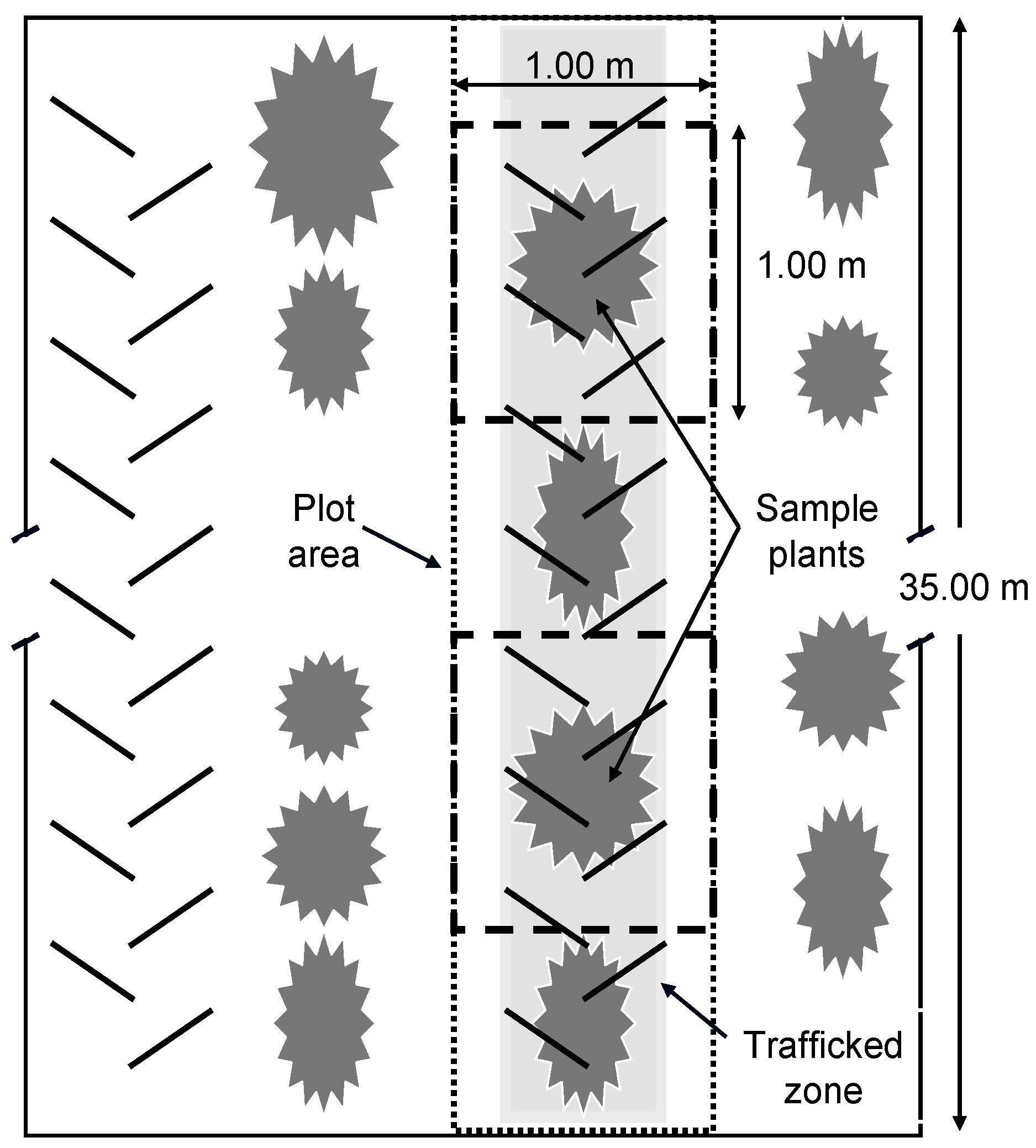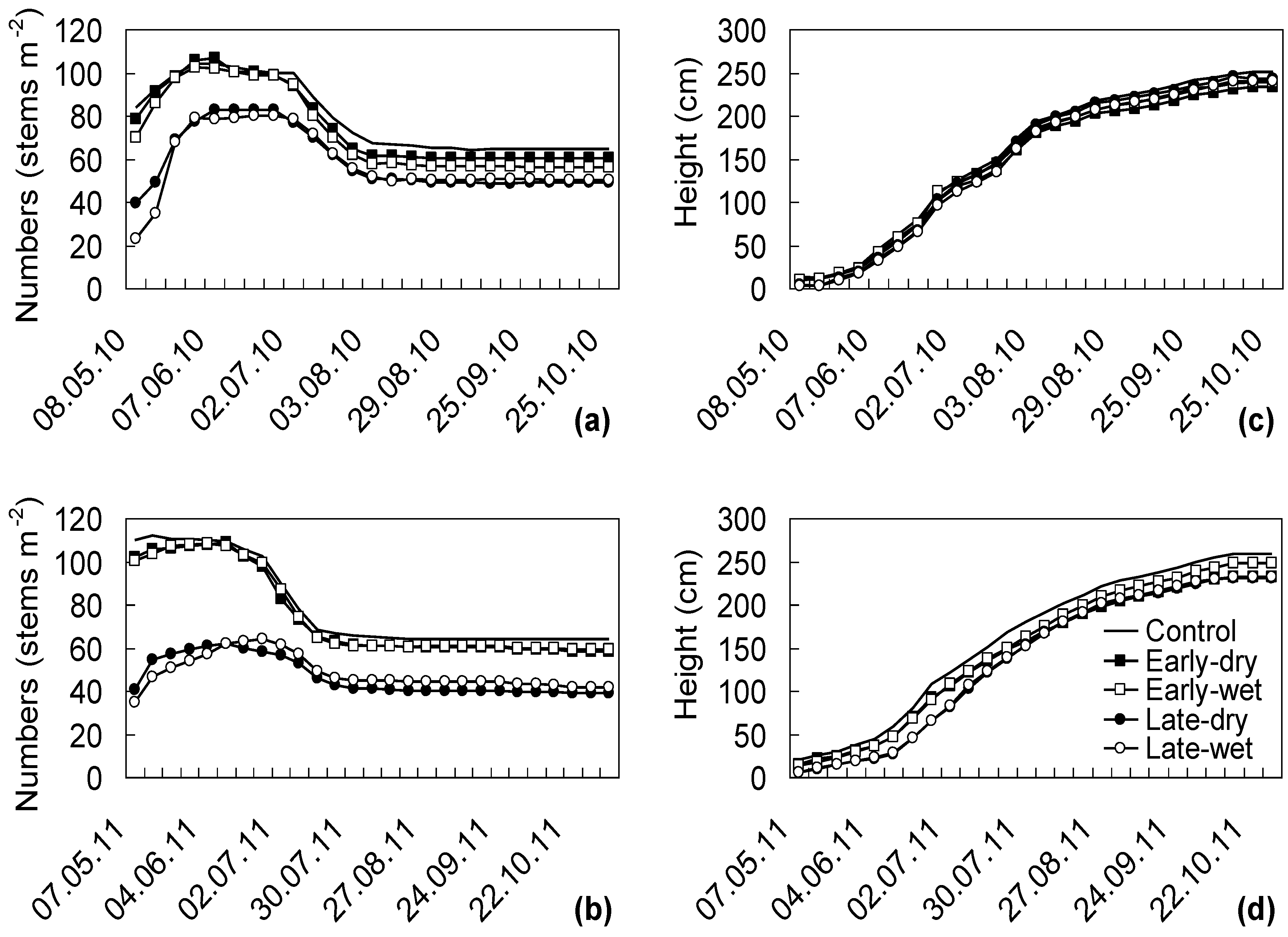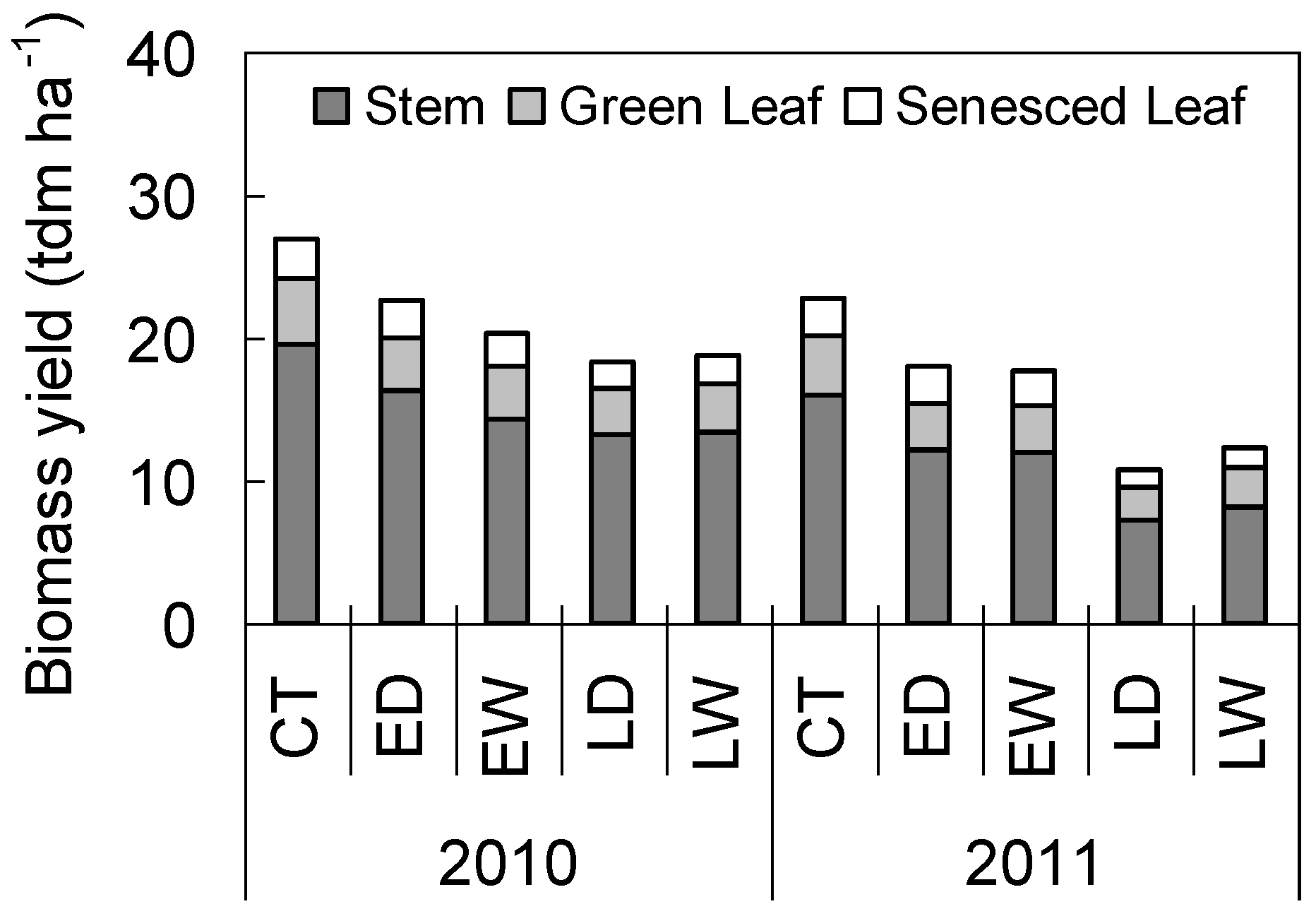Effect of Harvest Timing and Soil Moisture Content on Compaction, Growth and Harvest Yield in a Miscanthus Cropping System
Abstract
:1. Introduction
2. Materials and Methods
2.1. Site, Treatments, Equipment and Experimental Plots
- Control—no experimental traffic.
- Early-traffic on soil immediately below field capacity—(early-SMC as found).
- Early-traffic on soil at field capacity—(early-elevated SMC).
- Late-traffic on soil immediately below field capacity—(late-SMC as found).
- Late-traffic on soil at field capacity—(late-elevated SMC).
2.2. Measuring Soil Water Content
2.3. Assessing Crop Response
2.4. Assessing Soil Compaction
2.5. Meteorological Data
2.6. Statistical Analysis
3. Results
3.1. Crop Response
3.2. Stem Numbers in Trafficked Zone
3.3. Stem Height in Trafficked Zone
3.4. Biomass Yield in Trafficked Zone
3.5. Overall Stem Yield
3.6. Soil Compaction
4. Discussion
4.1. Soil Compaction
4.2. Crop Response
4.3. Harvest Timing
5. Conclusions
Author Contributions
Funding
Acknowledgments
Conflicts of Interest
References
- DCMNR. Delivering a Sustainable Energy Future for Ireland; Department of Communications, Marine and Natural Resources: Dublin, Ireland, 2017.
- McKendry, P. Energy production from biomass (part 1): Overview of biomass. Bioresource Technol. 2002, 83, 37–46. [Google Scholar] [CrossRef]
- Huisman, W. Optimising Harvesting and storage systems for energy crops in the Netherlands. In Proceedings of the International Conference on Crop Harvesting and Processing, Louisville, KY, USA, 9–11 February 2003. [Google Scholar]
- Scurlock, J.M.O. Miscanthus: A Review of European Experience with a Novel Energy Crop; Technical Report ORNL/TM-13732; Environmental Sciences Division, U.S. Department of Energy: Washington, DC, USA, 1999.
- Price, L.; Bullard, M.; Lyons, H.; Anthony, S.; Nixon, P. Identifying the yield potential of Miscanthus x giganteus: An assessment of the spatial and temporal variability of M. x giganteus biomass productivity across England and Wales. Biomass Bioenergy 2004, 26, 3–13. [Google Scholar] [CrossRef]
- Caslin, B.; Finnan, J.; Easson, L. Miscanthus Best Practice Guidelines; Agriculture and Food Development Authority, Teagasc, and Agri-Food and Bioscience Institute: Hillsborough, Northern Ireland, 2010.
- El Bassam, N.; Huisman, W. Harvesting and storage of Miscanthus. In Miscanthus for Energy and Fibre; Jones, M.B., Walsh, M., Eds.; Earthscan: London, UK, 2007; pp. 86–108. [Google Scholar]
- Lewandowski, I.; Clifton-Brown, J.C.; Scurlock, J.M.O.; Huisman, W. Miscanthus: European experience with a novel energy crop. Biomass Bioenergy 2000, 19, 209–227. [Google Scholar] [CrossRef]
- O’Flynn, M.G.; Finnan, J.M.; Curley, E.M.; McDonnell, K.P. Annually repeated traffic in delayed Miscanthus x giganteus harvests; effects on crop response and mitigation measures. Soil Till. Res. 2015, 148, 133–141. [Google Scholar] [CrossRef]
- Davies, B.; Eagle, D.; Finney, B. Soil Management; Farming Press: Ipswich, UK, 1972. [Google Scholar]
- Soane, B.D.; van Ouwerkerk, C. Soil compaction problems in world agriculture. In Soil Compaction in Crop Production, Developments in Agricultural Engineering Series; Soane, B.D., van Ouwerkerk, C., Eds.; Elsevier Science: Amsterdam, The Netherlands, 1994; pp. 1–21. [Google Scholar]
- Alameda, D.; Villar, R. Moderate soil compaction: Implications on growth and architecture in seedlings of 17 woody plant species. Soil Till. Res. 2009, 103, 325–331. [Google Scholar] [CrossRef]
- Douglas, J.T. Responses of perennial forage crops to soil compaction. In Soil Compaction in Crop Production, Developments in Agricultural Engineering Series; Soane, B.D., Van Ouwerkerk, C., Eds.; Elsevier Science: Amsterdam, The Netherlands, 1994; pp. 343–364. [Google Scholar]
- Glab, T.; Kopec, S. Effect of soil compaction on root system morphology and yields of meadow fescue (Festuca Pratensis). Pol. J. Environ. Stud. 2009, 18, 219–225. [Google Scholar]
- O’Flynn, M.G.; Finnan, J.M.; Curley, E.M.; McDonnell, K.P. Reducing crop damage and yield loss in late harvests of Miscanthus x giganteus. Soil Till. Res. 2014, 140, 8–19. [Google Scholar] [CrossRef]
- Tolon-Becerra, A.; Lastra-Bravo, X.B.; Botta, G.F.; Tourn, M.; Linares, P.; Ressia, M.; Balbuena, R. Traffic effect on soil compaction and yields of wheat in Spain. Span. J. Agric. Res. 2011, 9, 395–403. [Google Scholar] [CrossRef]
- Alakukku, L. Persistence of soil compaction due to high axle load traffic. I. Short-term effects on the properties of clay and organic soils. Soil Till. Res. 1996, 37, 211–222. [Google Scholar] [CrossRef]
- Souch, C.A.; Martin, P.J.; Stephens, W.; Spoor, G. Effects of soil compaction and mechanical damage at harvest on growth and biomass production of short rotation coppice willow. Plant Soil 2004, 263, 173–182. [Google Scholar] [CrossRef] [Green Version]
- Finch, J.W.; Karp, A.; McCabe, D.P.M.; Nixon, S.; Riche, A.B.; Whitmore, A.P. Miscanthus, Short-Rotation Coppice and the Historic Environment; Centre for Ecology and Hydrology, Natural Environment Research Council, Rothamsted Research: Lancaster, UK, 2009. [Google Scholar]
- Lalor, S.T.J. Soils of UCD Research Farm, Lyons Estate, Celbridge, Co. Kildare. Ph.D. Thesis, University College Dublin, Dublin, Ireland, 2004. [Google Scholar]
- WRB. World Reference Base for Soil Resources 2014; World Soil Resources Report 106; Food and Agriculture Organisation of the United Nations: Rome, Italy, 1998. [Google Scholar]
- ASAE Standard EP542. Soil Cone Penetrometer: Procedures for Using and Reporting Data Obtained; American Society of Agricultural and Biological Engineers: Michigan, MI, USA, 2003; pp. 1009–1011. [Google Scholar]
- ASAE Standard S313.3. Soil Cone Penetrometer; American Society of Agricultural and Biological Engineers: Michigan, MI, USA, 2003; pp. 859–860. [Google Scholar]
- ASTM D 3385 Standard Test Method for Infiltration Rate of Soils in Field Using Double-Ring Infiltrometer; ASTM International: West Conshohocken, PA, USA, 2009. [CrossRef]
- Met-Éireann. Weather Observing Stations. The Irish Meteorological Service Online. Available online: http://www.met.ie/about/weatherobservingstations/oakpark.asp (accessed on 20 September 2012).
- Kucharik, C.J.; VanLoocke, A.; Lenters, J.D.; Motew, M.M. Miscanthus establishment and overwintering in the Midwest USA: A regional modelling study of crop residue management on critical minimum soil temperatures. PLoS ONE 2013, 8, e68847. [Google Scholar] [CrossRef] [PubMed]
- Defossez, P.; Richard, G.; Boizard, H.; O’Sullivan, M.F. Modeling change in soil compaction due to agricultural traffic as function of soil water content. Geoderma 2003, 116, 89–105. [Google Scholar] [CrossRef]
- Tarawally, M.A.; Medina, H.; Frometa, M.E.; Itza, C.A. Field compaction at different soil-water status: Effects on pore size distribution and soil water characteristics of a Rhodic Ferralsol in Western Cuba. Soil Till. Res. 2004, 76, 95–103. [Google Scholar] [CrossRef]
- Trautner, A.; Arvidsson, J. Subsoil compaction caused by machinery traffic on a Swedish Eutric Cambisol at different soil water contents. Soil Till. Res. 2003, 73, 107–118. [Google Scholar] [CrossRef]
- Yavuzcan, H.G.; Matthies, D.; Auernhammer, H. Vulnerability of Bavarian silty loam soil to compaction under heavy wheel traffic: Impacts of tillage method and soil water content. Soil Till. Res. 2005, 84, 200–215. [Google Scholar] [CrossRef]
- Duiker, S. Avoiding Soil Compaction. College of Agricultural Sciences. Agricultural Research and Cooperative Extension. Available online: http://pubs.cas.psu.edu/freepubs/pdfs/uc186.pdf (accessed on 24 April 2007).
- Hakansson, I.; Reeder, R.C. Subsoil compaction by vehicles with high axle load—Extent, persistence and crop response. Soil Till. Res. 1994, 29, 277–304. [Google Scholar] [CrossRef]
- Arvidsson, J. Subsoil compaction caused by heavy sugarbeet harvesters in southern Sweden: I. Soil physical properties and crop yield in six field experiments. Soil Till. Res. 2001, 60, 67–78. [Google Scholar] [CrossRef]
- Botta, G.F.; Jorajuria, D.; Rosatto, H.; Ferrero, C. Light tractor traffic frequency on soil compaction in the Rolling Pampa region of Argentina. Soil Till. Res. 2006, 86, 9–14. [Google Scholar] [CrossRef]
- Hamza, M.A.; Anderson, W.K. Soil compaction in cropping systems: A review of the nature, causes and possible solutions. Soil Till. Res. 2005, 82, 121–145. [Google Scholar] [CrossRef]
- Forristal, D. Machinery, Tyres and the soil. In Proceedings of the Irish National Tillage Conference, Carlow, Ireland, 1 January 2003; pp. 83–99. [Google Scholar]
- Schjønning, P.; Lamandé, M.; Tøgersen, F.A.; Arvidsson, J.; Keller, T. Modelling effects of tyre inflation pressure on the stress distribution near the soil-tyre interface. Biosyst. Eng. 2008, 99, 119–133. [Google Scholar] [CrossRef]
- Alakukku, L.; Weisskopf, P.; Chamen, W.C.T.; Tijink, F.G.J.; van der Linden, J.P.; Pires, S.; Sommer, C.; Spoor, G. Prevention strategies for field traffic-induced subsoil compaction: A review: Part 1. Machine/soil interactions. Soil Till. Res. 2003, 73, 145–160. [Google Scholar] [CrossRef]
- Raper, R.L. Agricultural traffic impacts on soil. J. Terramech. 2005, 42, 259–280. [Google Scholar] [CrossRef]
- Clifton-Brown, J.C.; Long, S.P.; Jorgensen, U.; Humphries, S.A.; Schwarz, K.U.; Schwarz, H. Miscanthus productivity. In Miscanthus for Energy and Fibre; Jones, M.B., Walsh, M., Eds.; Earthscan: London, UK, 2007; pp. 46–67. [Google Scholar]
- Lewandowski, I.; Clifton-Brown, J.C.; Andersson, B.; Basch, G.; Christian, D.G.; Jorgensen, U.; Jones, M.B.; Riche, A.B.; Schwarz, K.U.; Tayebi, K.; et al. Environment and harvest time affects the combustion qualities of Miscanthus genotypes. Agron. J. 2003, 95, 1274–1280. [Google Scholar] [CrossRef]
- Meehan, P.G.; McDonnell, K.P.; Finnan, J.M. An assessment of the effect of harvest time and harvest method on biomass loss for Miscanthus × giganteus. Gcb Bioenergy 2013, 5, 400–407. [Google Scholar] [CrossRef]



| Depth (m) | Coarse Sand (2.0–0.5 mm) | Medium Sand (0.5–0.25 mm) | Fine Sand (0.25–0.05 mm) | Silt (0.05–0.002 mm) | Clay(<0.002 mm) |
|---|---|---|---|---|---|
| 0.00–0.15 | 71 | 46 | 200 | 360 | 323 |
| 0.15–0.28 | 78 | 45 | 201 | 364 | 312 |
| 0.28–0.40/0.48 | 91 | 72 | 289 | 315 | 233 |
| 0.40/0.48 + | 107 | 67 | 234 | 357 | 235 |
| Specifications of Equipment Used in the Trafficking Trials | |||
|---|---|---|---|
| (1) Tractor (4 wheel drive 4WD) and Mower | Front Axle | Rear Axle | Trailed Axle |
| Axle load (kg) | 2810 | 3230 | 1850 |
| Tyre size | 480/65 R 24 | 540/65 R 38 | 385/65/22.5 |
| Inflation pressure (kPa) | 160 | 160 | 160 |
| (2) Tractor (4WD) and baler | Front axle | Rear axle | Trailed axle |
| Axle load | 4040 | 4120 | 2700 |
| Tyre size | 540/65 R 28 | 650/65 R 38 | 23.1–26 |
| Inflation pressure | 160 | 160 | 160 |
| (3) Tractor (4WD) /front loader/bale | Front axle | Rear axle | |
| Axle load | 3360 | 2650 | |
| Tyre size | 480/65 R 24 | 540/65 R 38 | |
| Inflation pressure | 160 | 160 | |
| (4) Tractor (4WD) and bale trailer | Front axle | Rear axle | Trailed axle |
| Axle load | 3640 | 6560 | 9370 |
| Tyre size | 540/65 R 28 | 650/65 R 38 | 23.1–26 |
| Inflation pressure | 160 | 160 | 160 |
| April 1st to October 31st | Max. Air Temp. (°C) | Min. Air Temp. (°C) | Average Air Temp. (°C) | Total Rainfall (mm) | Average Soil Temp. at 0.10 m. (°C) |
|---|---|---|---|---|---|
| 2010 | |||||
| April | 18.1 | −3.4 | 8.3 | 32.7 | 9.6 |
| May | 24.9 | −2.0 | 10.2 | 44.9 | 13.3 |
| June | 23.8 | 4.5 | 14.8 | 45.2 | 17.5 |
| July | 23.6 | 9.4 | 15.9 | 81.7 | 17.3 |
| August | 21.4 | 2.2 | 13.9 | 43.5 | 16.1 |
| September | 22.3 | 1.4 | 13.4 | 102.7 | 14.1 |
| October | 18.6 | −2.5 | 10.1 | 37.7 | 10.3 |
| 2011 | |||||
| April | 21.8 | 0.0 | 10.9 | 30.0 | 11.9 |
| May | 18.1 | 4.1 | 11.4 | 51.5 | 12.6 |
| June | 22.5 | 2.3 | 12.4 | 65.1 | 14.9 |
| July | 22.9 | 4.7 | 14.1 | 53.1 | 16.6 |
| August | 22.1 | 4.8 | 13.6 | 51.6 | 15.3 |
| Date of Soil Moisture Measurement | ||||
|---|---|---|---|---|
| Treatment | 20 February 2010 | 24 April 2010 | 26 February 2011 | 22 April 2011 |
| Control—no experimental traffic | 0.44 | 0.34 | ||
| Early traffic on dry soil | 0.46 | 0.40 | ||
| Early traffic on wet soil | 0.46 | 0.44 | ||
| Late traffic on dry soil | 0.51 | 0.43 | 0.51 | 0.40 |
| Late traffic on wet soil | 0.52 | 0.51 | ||
| Rainfall (mm) | 2.9 | 0.0 | 15.0 | 6.3 |
| Stem Parameters in the Trafficked Zone | |||||||
|---|---|---|---|---|---|---|---|
| Treatment | Stem Number (m−2) | Stem Height (m) | Biomass Yield (tdm ha−1) | Stem Yield | Green Leaf Yield | Senesced Leaf Yield | Stem Yield |
| Control | 64.4 a | 2.55 a | 24.83 a | 17.77 a | 4.36 a | 2.69 a | 12.37 a |
| Early-dry | 59.3 a | 2.33 b | 20.31 ab | 14.20 ab | 3.47 ab | 2.63 a | 11.43 ab |
| Early-wet | 57.5 ab | 2.43 ab | 19.04 ab | 13.19 b | 3.45 ab | 2.38 a | 11.47 ab |
| Late-dry | 44.1 c | 2.37 ab | 14.57 b | 10.22 b | 2.70 b | 1.63 b | 10.42 b |
| Late-wet | 46.0 bc | 2.36 b | 15.50 b | 10.79 b | 3.02 b | 1.68 b | 10.12 b |
| 2010 | 56.1 | 2.41 | 21.42 a | 15.34 a | 3.69 a | 2.38 a | 11.07 |
| 2011 | 52.5 | 2.41 | 16.28 b | 11.12 b | 3.12 b | 2.03 b | 11.25 |
| Interaction | ns | ns | ns | ns | ns | ns | ns |
| Cone Penetration Resistance in MPa | ||||
|---|---|---|---|---|
| Depth (m) | 0.05 | 0.15 | 0.30 | 0.45 |
| Control | 0.58 a | 0.91 a | 1.20 a | 2.56 |
| Early-dry | 0.76 ab | 1.47 b | 1.89 b | 2.52 |
| Early-wet | 0.92 b | 1.46 b | 1.69 bc | 2.66 |
| Late-dry | 0.86 b | 1.37 b | 1.53 c | 2.52 |
| Late-wet | 0.89 b | 1.43 b | 1.65 c | 2.42 |
| 2010 | 0.76 | 1.16 a | 1.35 a | 2.56 |
| 2011 | 0.85 | 1.50 b | 1.80 b | 2.51 |
| Interaction | ns | s | s | ns |
| Bulk Density (g cm3) | ||||
|---|---|---|---|---|
| Depth (m) | 0.00–0.04 | 0.15 | 0.30 | 0.45 |
| Control | 1.28 a | 1.32 a | 1.35 a | 1.57 |
| Early-dry | 1.37 b | 1.39 b | 1.46 b | 1.62 |
| Early-wet | 1.39 b | 1.40 b | 1.47 b | 1.59 |
| Late-dry | 1.35 b | 1.43 b | 1.48 b | 1.54 |
| Late-wet | 1.37 b | 1.40 b | 1.47 b | 1.58 |
| 2010 | 1.33 a | 1.37 a | 1.43 | 1.61 |
| 2011 | 1.37 b | 1.40 b | 1.46 | 1.55 |
| Interaction | ns | ns | ns | ns |
© 2018 by the authors. Licensee MDPI, Basel, Switzerland. This article is an open access article distributed under the terms and conditions of the Creative Commons Attribution (CC BY) license (http://creativecommons.org/licenses/by/4.0/).
Share and Cite
O’Flynn, M.G.; Finnan, J.M.; Curley, E.M.; McDonnell, K.P. Effect of Harvest Timing and Soil Moisture Content on Compaction, Growth and Harvest Yield in a Miscanthus Cropping System. Agriculture 2018, 8, 148. https://doi.org/10.3390/agriculture8100148
O’Flynn MG, Finnan JM, Curley EM, McDonnell KP. Effect of Harvest Timing and Soil Moisture Content on Compaction, Growth and Harvest Yield in a Miscanthus Cropping System. Agriculture. 2018; 8(10):148. https://doi.org/10.3390/agriculture8100148
Chicago/Turabian StyleO’Flynn, Michael G., John M. Finnan, Edna M. Curley, and Kevin P. McDonnell. 2018. "Effect of Harvest Timing and Soil Moisture Content on Compaction, Growth and Harvest Yield in a Miscanthus Cropping System" Agriculture 8, no. 10: 148. https://doi.org/10.3390/agriculture8100148





